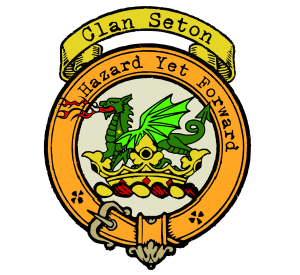Clan Seton Crest
|
|
CREST: On a ducal coronet, a dragon Vert, spouting fire Proper, with wings elevated and charged with a star Argent MOTTO: Hazard yet forward TRANSLATION: Whatever the peril, ever forward VARIATIONS: N/A |
| The Seton clan, also known as “Seaton” in some historical records, is believed to have originated from the village of Sai near Exmes in Normandy, France. By the mid-12th century, the Seton name had found its way to the Scottish lowlands, with Alexander de Seton witnessing a charter of King David I in 1150. This marked the beginning of the Seton clan’s presence in Scotland.
One of the defining moments in Clan Seton’s history occurred when Sir Christopher Seton married a sister of Robert the Bruce, Scotland’s legendary king. This marriage not only secured the Seton family’s fortunes but also forged a powerful bond with the Bruce dynasty. Sir Christopher’s role as a witness at Robert the Bruce’s coronation and his alleged heroic act in saving the king’s life at the Battle of Methven in 1306 are etched in the annals of Scottish history. In 1320, Sir Alexander Seton, likely a brother of Sir Christopher, played a pivotal role in Scotland’s fight for independence. He added his signature to the famous Declaration of Arbroath, a document asserting Scotland’s sovereignty and its right to self-determination. This declaration laid the foundation for the nation’s enduring struggle for independence. Sir Alexander Seton further solidified his legacy by serving as the governor of Berwick from 1327 to 1333. Berwick’s eventual surrender to the English during his tenure was a bitter pill to swallow. The English’s execution of Seton’s son, held hostage, added to the clan’s woes during this turbulent period. The Setons remained devoted to their country’s rulers throughout history. In the 16th century, they lent their unwavering support to Mary, Queen of Scots. The fifth Lord Seton played a significant role in her life, attending her wedding to the Dauphin of Viennois and holding important positions within her court. The Setons’ loyalty to Queen Mary was never more apparent than during her tumultuous reign. They played key roles in helping her escape dangerous situations, such as during the murder of her secretary, David Rizzio, and the sealing of her marriage contract with Lord Bothwell. When Queen Mary was imprisoned in Lochleven Castle in 1568, Seton and his followers aided in her daring escape. The Seton clan’s legacy endures through the titles and positions held by its members. Robert Seton, son of Lord Seton, was created the Earl of Winton by James VI in 1600. Alexander Seton reached the pinnacle of Scotland’s judiciary as Lord President of the Court of Session and Chancellor of Scotland. Other branches of the family, such as the Setons of Abercorn, made their mark in Scottish history. However, some members faced forfeiture due to their involvement in political conflicts, including the support of Viscount Dundee in 1689 and the 1715 rising. Several places along the Scottish coast, such as Port Seton, Seton Collegiate Church, and Seton House, serve as enduring memorials to the Seton clan’s remarkable history and contributions to Scotland. |
|
Citations:
|
|
Purchase @ Redbubble
Purchase @ Amazon.com
Purchase @ Amazon.co.uk

